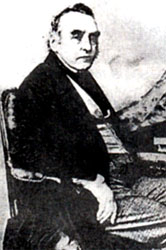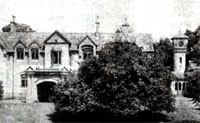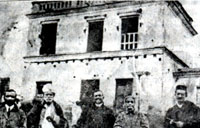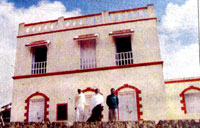
Gnarled, knobbed and twisted, Sullivan’s oak is an appropriate
metaphor for Ootacamund. On the one hand it is apparent that the
tree has been much better years; a 1905 photograph capture it
standing tall, robust and bushy before what were then the Secretariat
offices. On the other, it has survived the ravages of time; look
closer and you will discover that its branches have a tangled
beauty and that its alternate leaves glow softly in the wintry
sun.
John Sullivan, the man who founded Ooty, planted this oak over
150 years ago in front of what was then his residence, Stonehouse.
Over the years, Stonehouse was subsumed in flurry of construction
for the office of the Secretariat. And today, these offices have
become the Government Arts College – a tale of change and
continuity that is very much the story of Ooty.
|
| Identifying
Stone House |
  When
you are caught in the snarl and disorder that is Commercial Street;
are suffocated settle on the town in a noisy swarm; or are When
you are caught in the snarl and disorder that is Commercial Street;
are suffocated settle on the town in a noisy swarm; or are
looking at the “morden” box-like houses that are strung
out on the town in a pattern that resembles terrace cultivation;
you can’t help wondering whether Sullivan’s
Ooty has vanished forever. Yes it is lost. But yes, it also survives.
If you are armed with a sketch of an original ground plan and
elevation of Stonehouse, you can identify the exact portions of
the old residence- the very first European house in Ootacamund
– that were incorporated with the Secretariat office building.
If you walk through the over ground and beautifully unkempt cemetery
at St. Stephen’s, which lies on a small outcrop behind what
must be one of the country’s prettiest churches, you will
find the graves of Sullivan’s wife, Henrietta, and his 16-year-old
daughter, Harriet. They died within 10 days of each other in 1838.
The famous Ooty Lake – that serpentine stretch of water
that has deteriorated in to a sewer-was Sullivan’s creation
too. He dammed a stream in order to collect water for the nearby
fields, but somehow it never developed in to the headwater of
an irrigation system. Half the lake was appropriate and filled
in for the racecourse, but the other half still remains one of
the remains one of the main tourist attractions in the hill station.
But as Reverend Philip Mulley suggests, his real legacy goes well
beyond a building that endures here or a crumbling grave that
survives there. “ His impact is evident almost every where,”
says Mulley, who has keen interesting the history and sociology
of the Nilgiris.
It was Sullivan who revolutionised agricultural practice in these
mountains, there by changing the face of the local economy. He
did this not merely through the introduction of tea (which was
commercialized only years after his death), but by freely distributing
speed for a large assortment of cereals, fruit and vegetables.
He brought in European varieties of wheat and barley (which the
Badagas knew as Sullivan ganji), vegetables such as cabbage, radish
and turnip and fruits such as peach, apple and strawberry. It
was Sullivan who persuaded the initially skeptical Directors of
the East India Company to develop the Nilgiris as a sanatorium
for sick British troops. And it was Sullivan again who encouraged
the construction of the early ghat roads up in to the hills. As
anthropologist and Nilgiris expert Paul Hockings has noted: “His
impact was widespread and permanent.”
|
| Laying
the Foundation |
  Sullivan
didn’t ‘discover’ the Nilgiris, but he was the
first to see its potential as a sanatorium and he laid the foundations
that changed the social and economic face of these hills. Other
European had been up before. An enigmatic Jesuit priest, father
Fininicio, made The first expedition in 1603. He made the journey
up from Calicut, but all that remains of his visit to Todamala
is a small fragment that reveals he tried to converse with the
Badagas about Christianity and that he gave “Toda women
looking glasses and hanks of thread, with which they were very
much pleased”. Two centuries later, after the British had
annexed Mysore, There were other expeditions by men such as Buchanan,
Mackenzie, keys and MacMohan, some of them reaching only the lower
slopes. Sullivan
didn’t ‘discover’ the Nilgiris, but he was the
first to see its potential as a sanatorium and he laid the foundations
that changed the social and economic face of these hills. Other
European had been up before. An enigmatic Jesuit priest, father
Fininicio, made The first expedition in 1603. He made the journey
up from Calicut, but all that remains of his visit to Todamala
is a small fragment that reveals he tried to converse with the
Badagas about Christianity and that he gave “Toda women
looking glasses and hanks of thread, with which they were very
much pleased”. Two centuries later, after the British had
annexed Mysore, There were other expeditions by men such as Buchanan,
Mackenzie, keys and MacMohan, some of them reaching only the lower
slopes.
It was in 1818 that two youthful Assistant collectors of Coimbatore,
Whish and Kindersley, made it to the made it to the Nilgiris plateau.
It is not clear what took then up. One story goes they may have
been on a shooting expedition, another that they chasing tobacco
smugglers. Their account of their explorations, which were of
a place that was cool and teeming with the game and wildfowl,
stoked the interest of the boss. Sullivan, who was then the permanent
Collector of Coimbatore, made the ascent the following year. The
letter he wrote from the “Neilgherry hills” to Thomas
Munro, who went on to become Governor of Madras, is ecstatic.
“This is the finest country ever…. It resembles I
suppose Switzerland more than any other part of Europe…
the hills beautifully wooded and fine strong spring with running
water in every valley.” Within a few months, Sullivan had
constructed a small cottage a Dimhutti, near Kotagiri (See picture).
It had gone to ruin over the years, being used, among other things,
as a cowshed; only recently was it restored by the district administration,
thanks to the efforts of the environmental forum, the save Nilgiris
Campaign, and the enthusiasm of an energetic Collector. Two years
ago, D. Venugopal of the save Nilgiris Campaign, which has been
at the forefront of keeping Sullivan’s memory alive, organized
a trek that retraced the route he took up to the hills.
By 1822, Sullivan had started building stone house in what was
then known as Wotokymond, acquiring land from the Todas at one
rupee an acre. He would quickly corner huge tracts of land, many
times more than all the other European settler put together. All
the while ,Sullivan was peppering his superiors in Madras with
letters about the unusually temperate and healthy climate in the
Nilgiris and its suitability as a sanatorium. By 1828, there were
some 25 European houses, not to mention churches and the houses
of immigrants from the plains. This was also the year that Ooty
was made a military cantonment. Sullivan’s dream of making
it a sanatorium for British troops had been fulfilled, but the
governments action meant that Ooty would no longer be in his control
but in that of his rival Major William Kelso.
But Sullivan wasn’t through with Ooty. After he finished
his tenure as Collector of Coimbatore, he returned in his capacity
as the Senior Member of the Board of Revenue of the Madras Presidecy.
|
| Liberal
Views |
What
kind of man was he? The only surviving photograph (see picture)
presents a somewhat portly person, who seems both sad and sullen.
The only way of piecing his personality together is from scanty
official records. We know, for instance, that he was extremely
well disposed towards the tribal population – an attitude
that brought him into conflict with senior Government officials.
He argued, as early as 1832, that the “natives should be
entrusted with a great share in the administration of their own
affairs”. Remarkably, he also advocated the view that the
Todas had total proprietary rights over the lands in the Nilgiris
plateau and that they must receive compensation for any land acquired
from them. Considering the times he lived in, Sullivan’s
views suggest that he was an exraordinarily liberal man. H.B Grigg,
in his A Manual of the Nilgiri District in the Madras Presidency
(1880),describes him as a “friend of the native”.
At the same time, Sullivan laid himself open to charges that he
had used his position in government to acquire enormous personal
wealth. He retired and left to England in 1841 and died unsung
on January 16,1855 – exactly 150 years to this day. “Most
people in Ooty do not even know he existed,” says lawyer
and environmental activist B.J Krishnan. “But the important
thing for the future of these hills is that we retain the spirit
and energy of Sullivan.” The Save Nilgiris Campaign had
planned a procession of tribals and a public meeting on January
16, 2005 opn the occasion of his 150th death anniversary. |
|
|